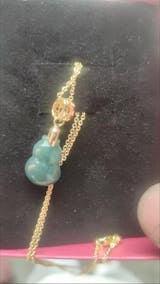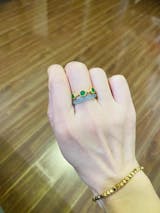Buddhists look within themselves for the truth and understanding of Buddha's teachings.
How did Buddhism begin?
About 2500 years ago, a prince named Siddhartha Gautama began to question his sheltered, luxurious life in the palace. He left the palace and saw four sights: a sick man, an old man, a dead man and a monk. These sights are said to have shown him that even a prince cannot escape illness, suffering and death. The sight of the monk told Siddhartha to leave his life as a prince and become a wandering holy man, seeking the answers to questions like "Why must people suffer?" "What is the cause of suffering?" Siddartha spent many years doing many religious practices such as praying, meditating, and fasting until he finally understood the basic truths of life. This realization occurred after sitting under a Poplar-figtree in Bodh Gaya, India for many days, in deep meditation. He gained enlightenment, or nirvana, and was given the title of Buddha, which means Enlightened One.
What did Buddha teach?
Buddha discovered Three Universal Truths and Four Noble Truths, which he then taught to the people for the next 45 years.
Three Universal Truths
Everything in life is impermanent and always changing.
Because nothing is permanent, a life based on possessing things or persons doesn't make you happy.
There is no eternal, unchanging soul and "self" is just a collection of changing characteristics or attributes.
Four Noble Truths
Human life has a lot of suffering.
The cause of suffering is greed.
There is an end to suffering.
The way to end suffering is to follow the Middle Path.
Buddha then taught people not to worship him as a god. He said they should take responsibility for their own lives and actions. He taught that the Middle Way was the way to nirvana. The Middle Way meant not leading a life of luxury and indulgence but also not one of too much fasting and hardship. There are eight guides for following the Middle path.
The Eightfold Path
Right understanding and viewpoint (based on the Four Noble Truths).
Right values and attitude (compassion rather than selfishness).
Right speech (don't tell lies, avoid harsh, abusive speech, avoid gossip).
Right action (help others, live honestly, don't harm living things, take care of the environment).
Right work (do something useful, avoid jobs which harm others).
Right effort (encourage good, helpful thoughts, discourage unwholesome destructive thoughts).
Right mindfulness (be aware of what you feel, think and do).
Right meditation (calm mind, practice meditation which leads to nirvana).
What is meditation?
Meditation is an essential practice to most Buddhists. Buddhists look within themselves for the truth and understanding of Buddha's teachings. They seek enlightenment, or nirvana, this way. Nirvana is freedom from needless suffering and being fully alive and present in one's life. It is not a state that can really be described in words -- it goes beyond words.
Meditation means focusing the mind to achieve an inner stillness that leads to a state of enlightenment. Meditation takes many forms:
It can be sitting quietly beside a beautiful arrangement of rocks, contemplating beauty.
It can be practicing a martial art such as karate or aikido since they require mental and physical control and strong concentration.
It can mean focusing on a riddle such as "What is the sound of one hand clapping?"
It can be contemplating a haiku or short poem that captures a moment in time.
It can be in a meditation room of a monastery.
It can involve chanting.
It can involve the use of a mandala to focus attention to the invisible point at the center of interlocking triangles.
It can involve quietly noticing one's breath as it goes in and out It can happen anywhere at any time.
Where are Buddha's words written down?
After Buddha died, his teachings were gradually written down from what people remembered. The Tripitaka, or The Three Baskets, is a collection of Buddha's sayings, his thoughts about them, and rules for Buddhists monks. The Tripitaka was first written on palm leaves which were collected together in baskets.
If Buddhism began in India, why is it all over some many eastern countries?
There are over 500 million Buddhists today. After Buddha's death, some of his followers had some differences of opinion which eventually led to their breaking away and forming separate kinds of Buddhism. There are two main types, Theravada, which spread to Sri Lanka, Myanmar, Thailand, Cambodia and Laos, and Mahayana which spread to Nepal, Vietnam, China, Korea and Japan. Mahayana took on aspects of the cultures where it was practiced and became three distinct branches: Vajrayana Buddhism or Tibetan Buddhism, Pure Land Buddhism and Zen Buddhism.
The Five Precepts
Even though each form of Buddhism took on its own identity, all Buddhists follow a set of guidelines for daily life called the Five Precepts. These are:
Do not harm or kill living things.
Do not take things unless they are freely given.
Lead a decent life.
Do not speak unkindly or tell lies.
Do not abuse drugs or drink alcohol.






























































